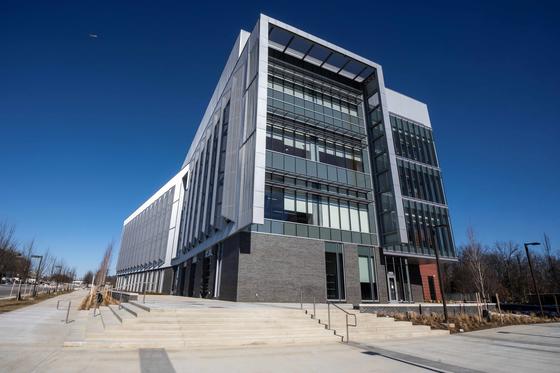George Mason University's new Life Sciences and Engineering Building at the Science and Technology Campus (SciTech Campus) in Manassas, Virginia, supports the university's growing need for highly specialized instructional labs, classrooms, and support spaces.

To meet the needs of the university and the commonwealth, in particular providing university access for students in Prince William, Fauquier, western Fairfax County, the cities of Manassas and Manassas Park, and beyond, the General Assembly and the Prince William delegation led by Delegate Luke Torian, chair of the House Appropriations Committee, was instrumental in strategic support and state funding for the new building.
With university classrooms and more than 30 different laboratory spaces for teaching, design, and fabrication, the building offers state-of-the-art facilities for training in disciplines like athletic training and kinesiology, microbiology, chemistry, engineering, forensic science, robotics and autonomous vehicles, and more. The building opened for classes for the spring 2025 semester.

“Designed for rigorous hands-on learning, the Life Sciences and Engineering Building marks a major state investment in our outstanding George Mason faculty to educate and inspire our students—Virginia’s next generation of leaders, researchers, innovators, and problem solvers,” George Mason President Gregory Washington said. “This facility, and the advancements it will produce, further establishes the Science and Technology Campus, and this Innovation District, as an anchor of the economic corridor that runs from Mason Square in Arlington to the Fairfax Campus to here in Manassas, further entrenching George Mason as a major driver of the prosperity of our region and state.”
The building will foster interdisciplinary connections across many academic units, including the College of Education and Human Development, College of Engineering and Computing, and the College of Science.

Encompassing 132,000 square feet of space, the building is designed to promote collaboration and engagement among students and faculty. The ground-level engineering labs and student design competition bays open directly onto the campus’ exterior pathways, allowing visibility into the work happening inside.
The project was originally planned as an expansion to Katherine G. Johnson Hall, an academic building at the SciTech Campus. When the university identified the need for additional labs, classrooms, and workspaces, the scope of the project changed to a four-story, free-standing building.
The SciTech Campus, which was established in 1997, will anchor a new Innovation District, which includes the development of two residential and commercial town centers directly connected to campus.
“The planned town centers will create a stronger link between the campus and the surrounding community,” said Colby Grant, director of administration and operations for the SciTech Campus. “Combined with the new Life Sciences and Engineering Building, these developments further establish the campus as a dynamic hub for science, technology, the arts, entertainment, and recreation.”
Read More Like This
- November 18, 2025
- October 9, 2025
- September 30, 2025
- September 10, 2025
- July 14, 2025
